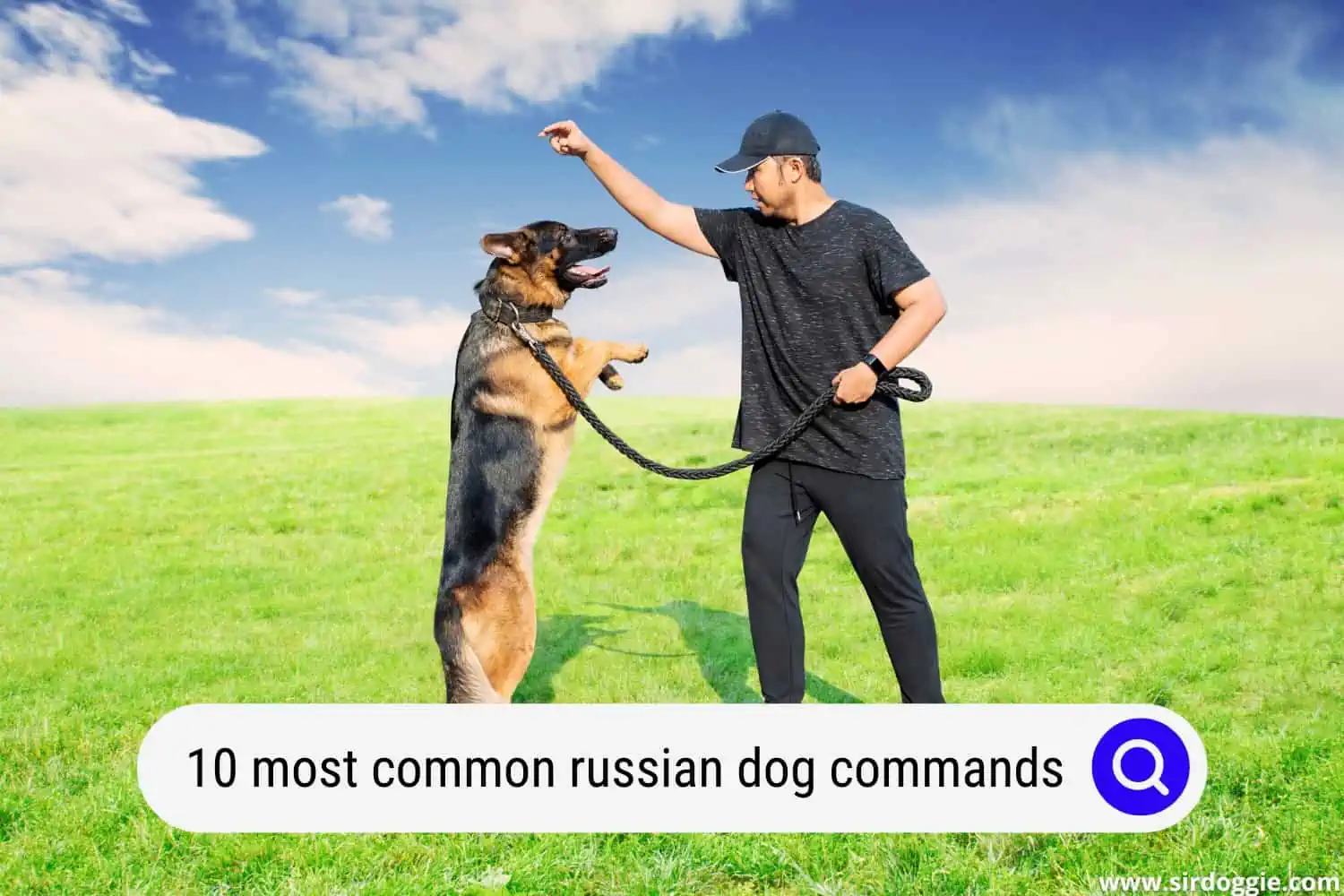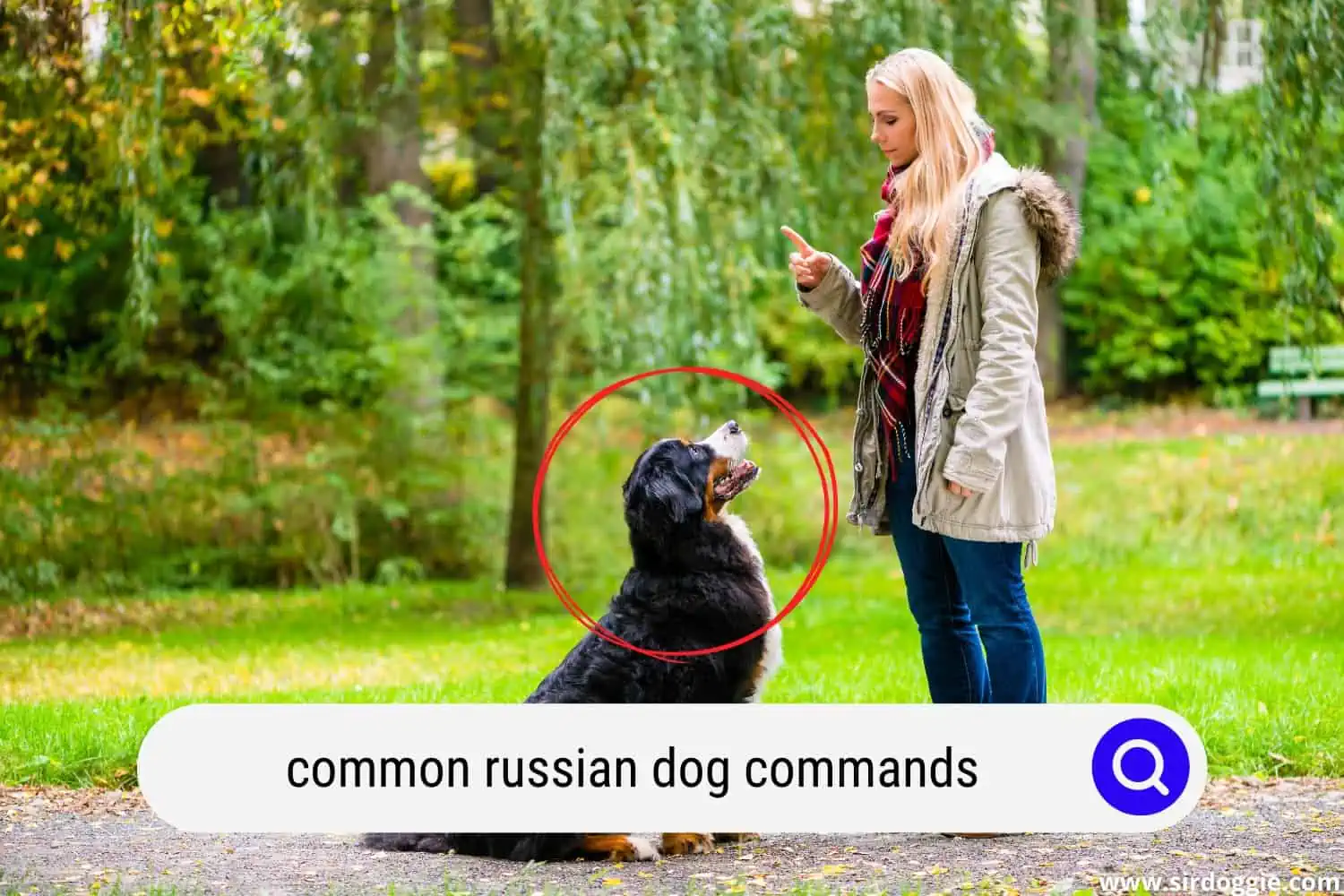Top 10 Most Common Russian Dog Commands
Are you looking forward to training your dog with some Russian dog commands? If yes, then you are in the right place.
Dog owners and trainers use verbal commands to communicate with their dogs during training. Russian dog commands are usually short and very simple to articulate and recall or remember.
Training your dog in Russian commands is fun and rewarding. You will need to make sure you can pronounce these commands correctly before trying to apply them without confusing your dog.

Some of the few essential and most significant Russian dog commands include:
1. Sit – Sidet (Сидеть)
Sit, being one of the most common commands taught, can also be one of the most confusing when taught in English. This is because the sound of the word is simple, one-syllable, and not as crisp sounding as its Russian counterpart. ‘Sidet’, the Russian word for sit, is distinguishable.
2. Heel – Ryadom ( Рядом)
‘Ryadom’ is a handy Russian dog command to use while working with your dog on its leash-walking skills. You should use it to order your dog to stand or walk beside you. This word means ‘Heel’ in English.
‘Ryadom’ is a much stronger sounding command, not easily mistaken. It is a necessary command for police and military dogs.
3. Jump – Preghet (Барьер)
‘Jump’ is considered a performance command and is easier to distinguish in its Russian form, ‘Preghet’. Teaching your dog the ‘Preghet’ command is gratifying for both you and your furry friend (and entertaining for spectators once you’ve nailed it).
4. Down – Lyezhat (ЛЕЖАТЬ)
Want your dog to lie down/get off of someone? ‘Down’ is again a simple command of one syllable. It is often better responded to in the Russian version of ‘Lyezhat. ‘Lyezhat’ command is both sharper and more to the point.
5. Stay – Myjesto (Дай)
When your dog should stay put, use the Russian dog command ‘Myjesto’.
Although ‘stay’ is a clear and easy command, ‘Myjesto’, the Russian word for stay, comes across as stronger. It is one of the basic commands with classical meaning – “stay” or “remain.”
6. Come – Komne (Ко мне)
This ‘Komne’ command is extremely helpful for those times you lose grip on the leash. ‘Komne’ command is easy to teach and will help keep your dog out of trouble.
Using the Russian alternative ‘Komne’, instead of the English ‘Come’ will have the added benefit of helping your dog differentiate who is doing the commanding. This is also an excellent option for an emergency command.
7. Good Boy – Molodets (МОЛОДЕЦ)
The ‘Good Boy’ command is a common one and can be confusing in social, dog-friendly circumstances; such as a play date with other dogs, a dog park, kennel, doggy daycare, or obedience school. So, training your dog to understand the Russian variation of ‘Molodets’ could be really helpful in distinguishing who is supposed to be the actual good boy (or girl).
8. Outside – Gutyat (Гуляй)
Telling your dog to go outside using the word ‘Outside’ would be sufficient, but it is much more fun to say ‘Gutyat’ which is the Russian version.
9. Fetch – Aport (Апорт)
You will often need to order your dog to bring something to you, especially if you have a hunting dog. If you throw a ball for your fur buddy and want them to bring it back to you, then the Russian dog command you need is ‘Aport’. This is a fun command and can be helpful when around other people. This word means “Bring,” or “Fetch,” in English.
10. Quiet – Tiho (Тихо), Molchat (молчать)
You need to teach your dog to be quiet on command. There are two ways to say ‘Quiet’ in Russian; ‘Tiho’ or ‘Molchat’. Which variant you will choose will depend on your preferences. No matter what choice you make, stick to it and do not vary between the two, so as not to confuse the dog.
The Benefits Of Teaching Russian Commands To Your Dog
It is becoming increasingly popular to train your dog in the Russian language daily. Many dog training experts say it’s better to teach your dog commands in some foreign language. This helps prevent your dog from becoming confused by other dog owner’s commands in public situations and also prevents strangers from calling or ordering your dog.
There are many advantages to choosing to train your dog in the Russian language.
- Russian dog commands are unlikely to be used in everyday conversations. So, they can help avoid confusion and allow you to communicate with your dog without any distractions.
- The sound and sharpness of Russian commands have better results as long as the dog obeys the commands.
- Russian dog commands help address a particularly problematic command. Rather than trying to retrain a problematic command, you can simply teach an entirely new Russian dog command.
- Training your dog to attack using the Russian command will not alert any ‘bad guys’ (in the case of a military dog, police dog, or guard dog).
- It will prevent any stranger from communicating with your dog without your permission.
- Finally, training your dog with Russian dog commands sounds darn cool. Speaking Russian to your dog will impress your friends, out on a stroll!
Russian Canine Life
Russia is home to a very diverse range of some of the coolest dog breeds in the canine world. Russia being the largest country on Earth, covers eleven different time zones. So, there is certainly enough room for many different breeds to form.
The dog breeds of Russia were all bred for specific purposes. These were shepherd dogs, guarding dogs, hunting dogs, and police dogs. Now, there are a few wonderful “pet” lap dogs that have been added to the Russian breeds. One thing is common in all Russian breeds: they can survive one of the harshest climates in the world.
Dog ownership is very popular among locals in Russia. They keep dogs for companionship in urban setups or guarding and outdoor work in more rural parts of the country.
The city of Moscow hosts a large population of stray dogs. It is interesting to note that up to 35,000 stray dogs live in Russia’s capital city. These stray dogs are present in markets, construction sites, or underground passageways, looking for food and trying to survive. The homeless dogs keep the city free of food leftovers and rats.
These stray dogs have adapted their behavior to the traffic and life of Moscow. Sadly, most homeless pups don’t reach adulthood, and those that do essentially replace adults who have died. A life of more than 10 years is considered very rare among Moscow strays.
These intelligent Russian stray dogs have figured out how to use the city’s immense and complex subway system. They can often be spotted traveling on the subway, waiting patiently for a train to pull in and its doors to slide open. Many of them operate in packs and have become accustomed to seeking food from passersby.
Popular Russian Dog Breeds
Let’s take a look at these distinct and fascinating dog breeds from Russia. Many Russian dog breeds are not well known outside Russia.
- Samoyed
- Siberian Husky
- Borzoi
- Russian Black Terrier
- Caucasian Shepherd Dog
- Central Asian Shepherd
- Karelian Bear Dog
- Eastern European Shepherd
- Russian Toy Terrier
- Russian Tsvetnaya Bolonka
- Sulimov Dog
- Russian Spaniel
- Yakutian Laika
- Russian Hound
- Taiwan or Russian Greyhound
- Russian Toy
- South Russian Ovcharka or Russian Sheepdog
Each Russian dog breed is different in its temperament, exercise level, and grooming requirements. When you are looking for a Russian puppy, you should see whether their general temperament and exercise requirements fit your lifestyle. Also, check out the genetic conditions they are prone to.

In Closing
Remember that dogs don’t understand the language as a whole, but with teaching, they can recognize words. Russian dog commands sound more distinct than their English counterparts and get quicker attention from your dog. If you teach your furry friend Russian words, it won’t recognize the English ones for the particular demand and vice versa.
If you want to try something different, teach your fur buddy at least a few Russian commands. Good luck!

Family Dog Expert Author
Hi there! I’m Stuart, a devoted dog lover and family dog expert with over a decade of experience working with our furry companions. My passion for dogs drives me to share my knowledge and expertise, helping families build strong, loving bonds with their four-legged friends. When I’m not writing for SirDoggie, you’ll find me hiking, playing with my beautiful dog, or studying music.